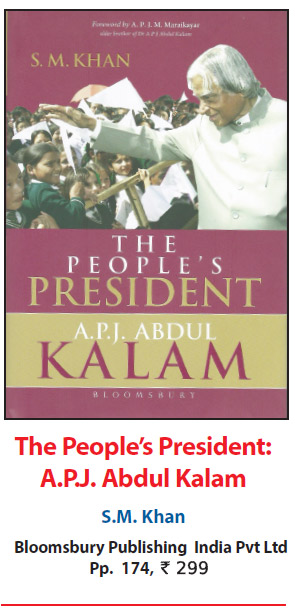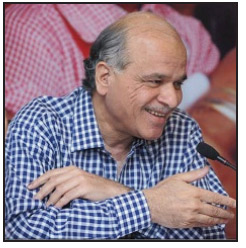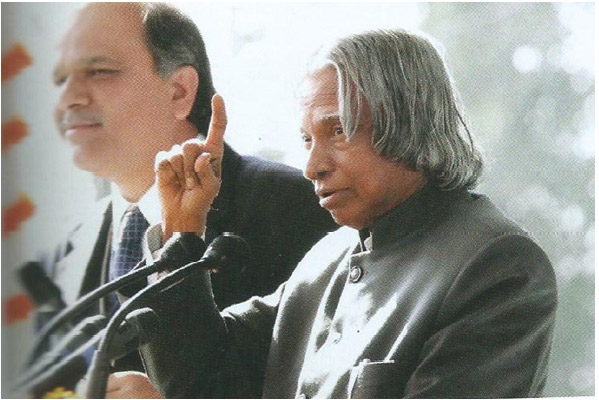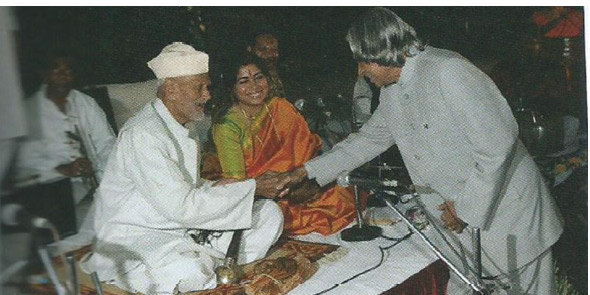Lest we forget a Great Dream !
Syed Nooruzzaman
Those living in Mosque
Street, Rameswarm (a small
town on Pamban Island in
Tamil Nadu's
Ramanathapuram district),
would never have thought
that the baby born in their midst on
October 15, 1931, was an
extraordinary soul, a gift of the
Almighty given to India to acquire the
status of the modern role model for
the country's children.
Of course, it was impossible to
realise at that stage that the little one -
-- Avul Pakir Jainulabdeen Abdul Kalam
-- would one day grow to become the
best choice to be invited to occupy the
highest constitutional position in the
country --- that of the President of
India.
 However, from Rameswaram to
Rashtrapati Bhawan was an arduous
journey for the person, for whom life
was not all cakes and ale. Luck first
guided him to find an entry into India's
scientific establishment, where he
worked hard with utmost dedication
to reach the peak in his field.
However, from Rameswaram to
Rashtrapati Bhawan was an arduous
journey for the person, for whom life
was not all cakes and ale. Luck first
guided him to find an entry into India's
scientific establishment, where he
worked hard with utmost dedication
to reach the peak in his field.
He considered Dr Vikram Sarabhai,
father of India's space programme, as
his role model from whom he drew
inspiration to remain dedicated to his
work during his years of trial and
tribulation Ultimately, Kalam emerged as one
of the most valuable scientific brains to
preside over India's missile
programme to earn that coveted
sobriquet, The Missile Man.
But that was not all that providence
had in store for Kalam. There came a
time when the nation's search for a
new occupant of Rashtrapati Bhawan
ended at his door. Almost everybody who was somebody during Atal Behari
Vajpayee's Prime Ministership
unanimously agreed that The Missile
Man was the most suitable person to
adorn the chair of the President of
India.
Samajwadi Party supremo
Mulayam Singh Yadav has been
claiming that it was originally his idea
which was lapped up by Vajpayee.
That is, however, not as important as
the fact that Kalam was destined to
The book provides an
interesting and very
meaningful insight into
the life of Dr Kalam,
particularly after he got
elevated as the President
of India. It has been
written with passion,
showing great
admiration for the man
who, as Khan says,
"continues to live in the
imagination of the
people, particularly the
youth of the nation".
occupy the highest constitutional
position in the country and he did it
with distinction.
 SM KHAN
The book under review, "The
People's President", by S.M. Khan,
Press Secretary to the late President
Kalam for five years from August 2002,
brings out in vivid detail the qualities
of head and heart of Kalam.
SM KHAN
The book under review, "The
People's President", by S.M. Khan,
Press Secretary to the late President
Kalam for five years from August 2002,
brings out in vivid detail the qualities
of head and heart of Kalam.
He loved interacting with everybody, but children acquired the
pride of place in his scheme of things.
He had himself childlike curiosity
about understanding different issues,
and would feel at ease while mingling with
youngsters. During his tenure as
President "School students
were invited (to Rashtrapati Bhawan)
every week. They would first visit the
Children's Gallery, which Dr Kalam had
set up in Rashtrapati Bhawan, and
then they would interact with the
President.
 President Kalam addressing an audience in his characteristic style. The
author is standing by his side
Their interaction would last about
an hour", as Khan mentions in his
book.
President Kalam addressing an audience in his characteristic style. The
author is standing by his side
Their interaction would last about
an hour", as Khan mentions in his
book.
The intensity of his fascination for
children, the future of any society, can
be easily understood from the fact that
Dr Kalam dedicated his book, "Ignited
Minds", to a class 12 school student of
Anandalaya High School of Anand,
Gujarat. He was moved to take this
decision when the girl student, in reply
to the question "Who is our enemy?",
said, "Our enemy is poverty".
However, his love for people was
not limited to youngsters. He liked
meeting people coming from all
sections of society. As the author
points out in the book, "…right since
the day he was sworn in, he wanted Rashtrapati Bhawan to be a people's
place, where their grievances would be
addressed." It was not for nothing that
he earned another sobriquet from the
media and the masses, the "People's President".
 President Bharat Ratna Dr Kalam with another Bharat Ratna Ustad
Bismillah Khan at the latter's concert in Rastrapati Bhavan
His election as the 11th President of
India got hearty welcome from the
media all over the country. In the words of S.M. Khan, "In fact, even
before his name was announced,
senior columnists and editors were
suggesting his name as one of the
choices. Noted columnist and Editorin-
Chief, Shri Hari Jaisingh, wrote on 7
June 2002 in The Tribune, Chandigarh two weeks before the announcement
of his candidature: "I would like to
have someone (as President) who is
cent per cent Indian at heart and
Indian in his outlook. One such
outstanding Indian is APJ Abdul Kalam.
What is needed today is the ability to
think Indian and act Indian --- beyond
the majority and minority syndrome.
This is where Dr Kalam stands out as
among the few tallest Indians."
President Bharat Ratna Dr Kalam with another Bharat Ratna Ustad
Bismillah Khan at the latter's concert in Rastrapati Bhavan
His election as the 11th President of
India got hearty welcome from the
media all over the country. In the words of S.M. Khan, "In fact, even
before his name was announced,
senior columnists and editors were
suggesting his name as one of the
choices. Noted columnist and Editorin-
Chief, Shri Hari Jaisingh, wrote on 7
June 2002 in The Tribune, Chandigarh two weeks before the announcement
of his candidature: "I would like to
have someone (as President) who is
cent per cent Indian at heart and
Indian in his outlook. One such
outstanding Indian is APJ Abdul Kalam.
What is needed today is the ability to
think Indian and act Indian --- beyond
the majority and minority syndrome.
This is where Dr Kalam stands out as
among the few tallest Indians."
The author records that while
addressing a gathering of media
persons and others on the occasion of
National Press Day, on November 16,
2006, Dr Kalam expressed the view,
"The media, in addition to news
analysis, views and reporting, should
carry out research to self-evaluate its
role in the uplift of society."
The book provides an interesting
and very meaningful insight into the
life of Dr Kalam, particularly after he
got elevated as the President of India.
It has been written with passion,
showing great admiration for the man
who, as Khan says, "continues to live in
the imagination of the people,
particularly the youth of the nation".
Dr Kalam wanted India to achieve
the status of a developed nation by
2020. He had come out with a blueprint also as Vision 2020 to ensure
that this objective was achieved. Now
it is the responsibility of those at the
helm of affairs to see how the great
dream of the People's President can be
realised by the time he had
envisioned.





 SM KHAN
SM KHAN President Kalam addressing an audience in his characteristic style. The
author is standing by his side
President Kalam addressing an audience in his characteristic style. The
author is standing by his side President Bharat Ratna Dr Kalam with another Bharat Ratna Ustad
Bismillah Khan at the latter's concert in Rastrapati Bhavan
President Bharat Ratna Dr Kalam with another Bharat Ratna Ustad
Bismillah Khan at the latter's concert in Rastrapati Bhavan